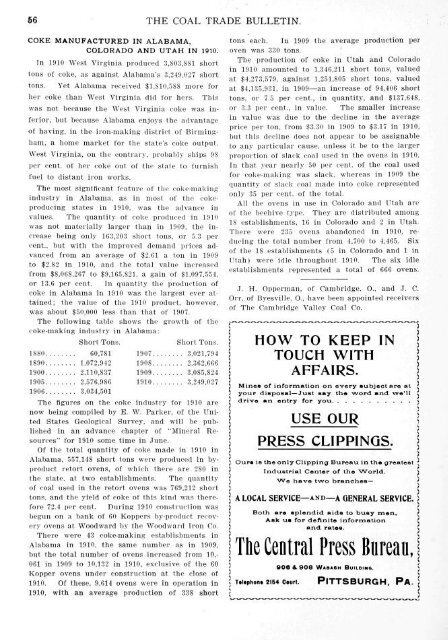u,.:- • - Clpdigital.org
u,.:- • - Clpdigital.org
u,.:- • - Clpdigital.org
Create successful ePaper yourself
Turn your PDF publications into a flip-book with our unique Google optimized e-Paper software.
56 THE COAL TRADE BULLETIN.<br />
COKE MANUFACTURED IN ALABAMA,<br />
COLORADO AND UTAH IN 1910.<br />
In 1910 West Virginia produced 3,803,881 short<br />
tons of coke, as against Alabama's 3,249,027 short<br />
tons. Yet Alabama received $1,810,588 more for<br />
her coke than West Virginia did for hers. This<br />
was not because the West Virginia coke was in<br />
ferior, but because Alabama enjoys the advantage<br />
of having, in the iron-making district of Birming<br />
ham, a home market for the state's coke output.<br />
West Virginia, on the contrary, probably ships 98<br />
per cent, of her coke out of the state to furnish<br />
fuel to distant iron works.<br />
The most significant feature of the coke-making<br />
industry in Alabama, as in most of the cokeproducing<br />
states' in 1910. was the advance in<br />
values. The quantity of coke produced in 1910<br />
was not materially larger than in 1909. the increase<br />
being only 163,203 short tons, or 5.3 per<br />
cent., but with the improved demand prices advanced<br />
from an average of $2.61 a ton in 1909<br />
to $2.82 in 1910, and the total value increased<br />
from $8,068,267 to $9,165,821, a gain of $1,097,554,<br />
or 13.6 per cent. In quantity the production of<br />
coke in Alabama in 1910 was the largest ever attained;<br />
the value of the 1910 product, however,<br />
was about $50,000 less than that of 1907.<br />
The following table shows the growth of the<br />
coke-making industry in Alabama:<br />
Short Tons. Short Tons.<br />
1880 60,781 1907 3.021,794<br />
1890 1,072,942 1908 2.362,666<br />
1900 2,110,837 1909 3,085,824<br />
1905 2,576,986 1910 3.249,027<br />
1906 3,034,501<br />
The figures on the coke industry for 1910 are<br />
now being compiled by E. W. Parker, of the United<br />
States Geological Survey, and will be published<br />
in an advance chapter of "Mineral Resources"<br />
for 1910 some time in June.<br />
Of the total quantity of coke made in 1910 in<br />
Alabama, 557,148 short tons were produced in byproduct<br />
retort ovens, of which there are 280 in<br />
the state, at two establishments. The quantity<br />
of coal used in the retort ovens was 769,212 short<br />
tons, and the yield of coke of this kind was therefore<br />
72.4 per cent. During 1910 construction was<br />
begun on a bank of 60 Koppers by-product recovery<br />
ovens at Woodward by the Woodward Iron Co.<br />
There were 43 coke-making establishments in<br />
Alabama in 1910, the, same number as in 1909,<br />
but the total number of ovens increased from 10,-<br />
061 in 1909 to 10,132 in 1910, exclusive of the 60<br />
Kopper ovens under construction at the close of<br />
1910. Of these, 9,614 ovens were in operation in<br />
1910, with an average production of 338 short<br />
tons each. In 1909 the average production per<br />
oven was 330 tons.<br />
The production of coke in Utah and Colorado<br />
in 1910 amounted to 1,346,211 short tons, valued<br />
at $4,273,579, against 1,251,805 short tons, valued<br />
at $4,135,931, in 1909—an increase of 94,406 short<br />
tons, or 7.5 per cent., in quantity, and $137,648,<br />
or 3.3 per cent., in value. The smaller increase<br />
in value was due to the decline in the average<br />
price per ton, from $3.30 in 1909 to $3.17 in 1910,<br />
but this decline does not appear to be assignable<br />
to any particular cause, unless it be to the larger<br />
proportion of slack coal used in the ovens in 1910.<br />
In that year nearly 50 per cent, of the coal used<br />
for coke-making was slack, whereas in 1909 the<br />
quantity of slack coal made into coke represented<br />
only 35 per cent, of the total.<br />
All the ovens in use in Colorado and Utah are<br />
of the beehive type. They are distributed among<br />
18 establishments, 16 in Colorado and 2 in Utah.<br />
There were 235 ovens abandoned in 1910, reducing<br />
the total number from 4,700 to 4,465. Six<br />
of the 18 establishments (5 in Colorado and 1 in<br />
Utah) were idle throughout 1910. The six idle<br />
establishments represented a total of 666 ovens.<br />
J. H. Opperman, of Cambridge. O., and J. C.<br />
Orr, of Byesville, O., have been appointed receivers<br />
of The Cambridge Valley Coal Co.<br />
P~ ~~~~~~~~~-~-~———^<br />
HOW TO KEEP IN<br />
| TOUCH WITH<br />
j AFFAIRS. |<br />
3 Mines of information on every subject are at r<br />
i your disposal—Just say the word and we'll I<br />
) drive an entry for you S<br />
USE OUR I<br />
PRESS CLIPPINGS.<br />
5 Ours is the only Clipping Bureau in tha greatest f<br />
f Industrial Center of the World. 5<br />
\ We have two branches— ?<br />
\ A LOCAL SERVICE—AND—A GENERAL SERVICE.<br />
) Both are splendid aids to busy men, r<br />
i Ask us for definite information c<br />
3 and rates. (<br />
j The Central Press Bureau, [<br />
006 & 008 WAB«6H BUILDING. \<br />
: T.ltphon. 2164 Court. PITTSBURGH, PA.<br />
\
















